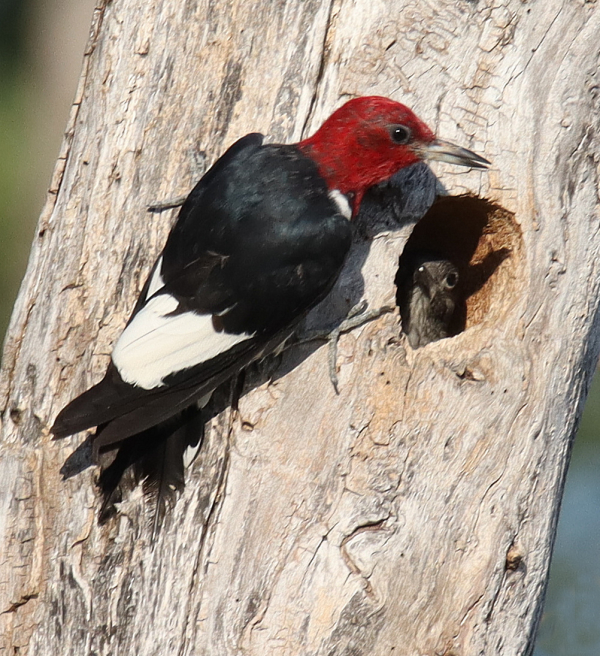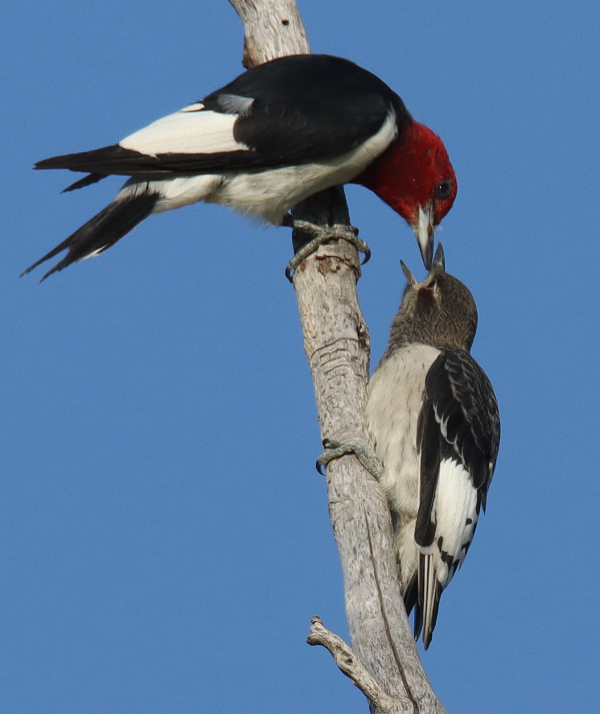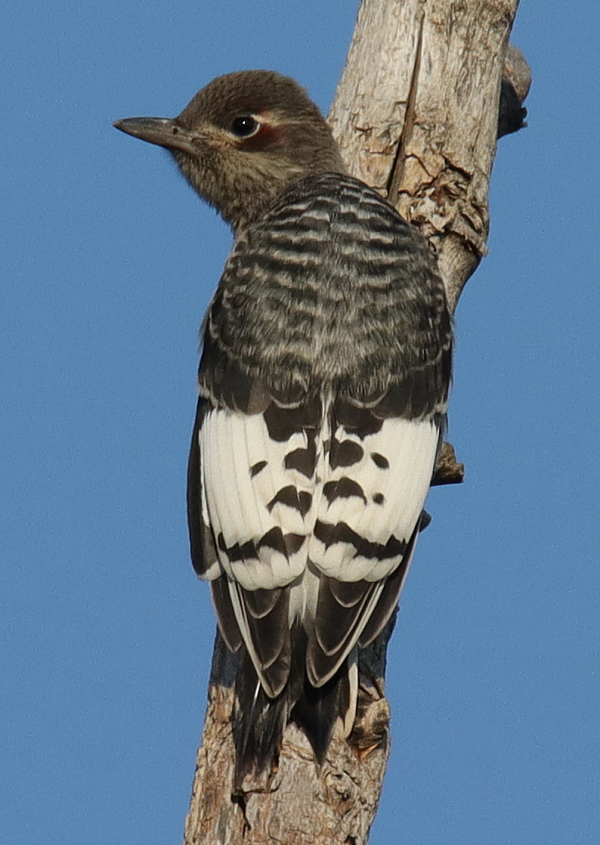Woodpeckers are an interesting family of birds and among the most attractive photo subjects for many birders. I’m always excited to see a woodpecker and hope for a chance to photograph any I see, but woodpeckers can be especially difficult to photograph. They are usually wary, even when frequenting feeding stations, and they tend to stay in the shadows of tree trunks, branches, and leaves. My experience has been that my best opportunities to photograph woodpeckers is to try to photograph them at locations where they hunt on the wing within a nesting territory – usually when they become more actively procuring food for older nestlings.
That said, it’s always imperative to keep the birds’ best interests and well-being in mind when trying to photograph them, especially when they are engaged in nesting and food gathering activities. The key to photographing during this period is to keep your distance, and see how individual birds react when you approach them. Some woodpeckers are more trusting than others; some get accustomed to a vehicle, which I use as a “mobile blind;” others never seem to accept a parked vehicle.
As summer was waning, I had 2 promising pairs of Red-headed Woodpeckers that I tried to approach for photography. The first pair was active at a traditional Red-head territory where I have photographed during previous years, but judging by the very wary behavior of the pair on hand this season, they were a new pair and it was quickly obvious they were not good candidates to photograph. But there was another pair on territory about ¾ mile south that was quite accommodating for an occasional afternoon photo stop.

What a thrill when an adult first revealed the location of its nesting cavity as it took insects to a large feathered nestling (photo tech: 600mm zoom lens, f-8 aperture, 1/800 shutter speed, ISO 400).
|
I’m always excited to see Red-headed Woodpeckers, and always interested in photographing them, so they are a great example for me to share some insights into photographing woodpeckers. A couple weeks ago when I checked on the south pair of woodpeckers, both adults were on the hunt a couple hours before sunset. The trees the Red-heads perch on are on the east side of a rarely used rural road, which made late afternoon prime time to try to photograph these birds when the sunlight illuminated them and their surroundings.
Although I checked on the woodpeckers from time to time, I didn’t expect the situation to amount to more than trying to take a nice portrait of these beautifully colored woodpeckers, which I was able to do a couple times as they perched on favored dead trees near the road. Even so, I was also watching for fledglings that might appear toward the end of August.
One afternoon, I stopped and was able to take a representative portrait of one of the adults as it perched in a dead tree that had no bark and was colored skeletal white – after all they were tree skeletons now, right? Taking the photos that afternoon required a bit of time, a bit of luck, and some patience. As woodpeckers are prone to do, this one often positioned itself behind a tree branch, peering from behind the branch, but it also made itself available in the open, clinging to a vertical branch or perching atop a more horizontal one.
At the same time, the woodpecker was making hunting flights from the tree, an activity that can be referred to as “hawking insects.” When it sighted a bug flying at about its eye level it flew to catch the insect, sometimes a quick flight with a return to the tree. Or sometimes it became an extended flight with some aerial acrobatics involved. Both hawking flights tended to create a circular flight starting and ending at a perch on the dead tree. Of course I tried to photograph the woodpecker in flight too, but I found that to be worthy of a try, but with little success – that’s another story. I did get some nice images of the woodpecker perched on the tree, some with insects in its bill.

Although we must be always be especially careful not to impact birds when photographing near an active nest site, it was clear in this case that a very short photo session didn’t affect the behavior of the birds, including this soon to fledge nestling (600mm zoom, f-7 aperture, 1/1250 shutter speed, ISO 400).
|
Phase 2
Five days later, as I approached that woodpecker territory, I could see 2 Red-heads perched on dead branches adjacent to the road. I stopped at a good location to try to photograph, and in a moment a woodpecker flew to the gravel road in front of my car to grab an insect, then flew to a different dead tree where it landed rather low on the side of the trunk. As I watched, the Red-headed Woodpecker ‘crawled’ horizontally to a perfectly circular hole in the trunk, then reached over to feed the insect to a large nestling! The woodpecker just showed me its nest site!
The round nesting cavity entrance was illuminated well in the late afternoon sunlight, so I waited to see if the adult would return, but kept my attention and my camera lens focused on the large, mostly gray-feathered nestling that appeared to be likely to fledge soon. The adult returned to the cavity entrance repeatedly to feed the nestling, and while I photographed as best I could from the road, I really wanted to try to get closer – but not too close. The woodpeckers showed no signs of concern about my car parked nearby, or when it moved a few feet forward or backward to get into better positions, so I considered how I could get a little closer to take a few photos.
About 40 feet east of the road, closer to the nest tree, there was a cut-grass access lane that farm machinery probably used to enter an adjacent cornfield. It would permit me to carefully drive my mobile blind (my car) closer, so I tried driving slowly, carefully down the lane and into position to photograph the woodpecker action at the nesting cavity entrance. I checked the hole with binoculars and the gray-headed nestling had its head poking out of the entrance, still without concern for the white car. And in a minute an adult flew in to land next to the cavity, pause a moment as usual, then lean over to pass food to the nestling – hoooray, how lucky!
Having the utmost concern for the woodpeckers, they seemed to be unconcerned with my closer approach, allowing me to take photos during a couple more food exchanges, and then I politely, slowly eased back to the road and wished them well. I was very happy with the resulting photos, and knowing the nestling could leave the cavity any day. I checked back almost daily, but found no sign of a fledgling in the cavity entrance or in the surrounding trees, although an adult was present during one drive-by. But the following Friday, 5 days after I photographed the nestling in the cavity, there was a flurry of action at the dead tree near the road with both adults actively hunting flying insects during my 45 minutes of observations.

Seeing the first new fledgling and having a chance to photograph it was exhilarating. The photos of the fledglings provide interesting looks at the “gray-headed” plumage of first year Red-headed Woodpeckers (600mm zoom, f-8 aperture, 1/1250 shutter speed, ISO 400).
|
Again, I didn’t see any action at the nesting cavity entrance, suggesting all the more that the nestling fledged soon after I photographed it. But suddenly, a gray-headed fledgling flew to the dead tree! It only alighted a moment before reversing into the cover of adjacent trees. Even so, it was a breakthrough just to see the fledgling in action. I also saw the fledgling from quite a distance (or was it a second fledgling) as it flew to a distant dead tree where one of the adults was perched. I took a couple long-distance documentary photos of the young woodpecker, and hoped for a closer photo opportunity.
That’s when an interesting thing happened: One of the adult Red-heads flew to the nesting cavity with a moth in its beak, entered the cavity, then peered out of the cavity hole similar to how the nestling did before. Was there another nestling inside the cavity? Or was the adult placing an insect into the cavity for a fledgling to find? When the adult left the cavity, it flew to the dead tree near the rural road, providing a photo op, and then it happened: A fledgling landed on the same tree in full sight, providing me with an introductory photo, and it stayed and repositioned to offer a couple different looks from the side and back – what luck, what fun.
During my next visit to the woodpecker territory, both adults were on site, and I spent the first half of the hour trying to photograph the birds in flight. At the same time, I could see they appeared to be stashing insects they caught into cracks in dead branches, and in natural cavities and holes in the trunk or branches – Hmm. And that’s when a fledgling flew in to monitor the action. I was thrilled to have a few opportunities to photograph the fledgling on different perches, then photographed a food exchange between an adult and the fledgling.
I also saw the fledgling visit some of the cache sites, especially a long crack in a dead branch that an adult loaded with insects earlier. Could this be a way of introducing the fledgling to search for food in such cracks, crevices, and cavities in trees? But this fledgling was already fairly well versed in food collection, considering that its next move was to fly from a perch and attempt to catch flying insects on its own. It was hard to tell if the fledgling was making any catches, but it was exciting to see it trying.
Moments later, a second fledgling landed on a nearby branch; the first verification that there were at least 2 fledglings. This one also made aerial hunting flights, and was fed by an adult periodically. When an adult was feeding one fledgling, the other one invariably tried to get a portion, initiating a little tussle that included wing flaps between the fledglings. This observation period proved to be especially insightful and I managed to take a few especially nice photos. As the sunlight dimmed and I left the woodpeckers, I reflected on the fact that the birds seemed to become more active after 6pm, perhaps due to increased insect activity, which may also have been due to subdued wind or lower light conditions.

When photographing birds we find that some individuals are more trusting than others, and this pair of Red-headed Woodpeckers and their fledglings seemed undaunted by a white car that was rarely parked near their favorite tree. It’s always rewarding when birds share their most intimate interactions as you photograph, such as this food exchange between an adult and its recent fledgling (600mm zoom, f-8 aperture, 1/1250 shutter speed, ISO 400).
|
Photo Properties
Although the Red-headed Woodpeckers were usually perched 15 to 20 feet above my seated position, by positioning a distance away, the angle of my camera hinted that I was at a similar level as the birds, which was far from true. I prefer not to show birds from beneath, whether its woodpeckers, warblers, or other birds.
The perches being used by adult and fledgling woodpeckers provided a nice setting – leafless gray to white-colored tree branches or barkless tree trunks set off by a blue sky background that emphasized the birds and their perches. Using my Tamron 150-600mm zoom lens, usually at the maximum 600mm zoom setting, I braced the lens against the window frame of my car, and held my breath when lightly pressing the shutter button to avoid as much camera shake as possible.
As always, I positioned myself between the sun and the woodpeckers, with the sun beaming afternoon light on the woodpeckers and their surroundings. As for camera settings, I use the Av mode, then set the aperture (f-stop), while the camera automatically provides the compensating shutter speed. I kept my camera’s settings at my usual f-8 aperture, which provided more than adequate shutter speeds using an ISO 400 setting in bright sunlight. Any time I photograph in optimum lighting conditions, I have my camera pre-set at those levels, then adjust any as needed when photographing in the moment. In this case, there was no need to make any changes, and the resulting photos were perfectly exposed, sharp, and clear.

Perfect late afternoon lighting provided a detailed view of the dorsal plumage of a fledgling, showing how different this first-year plumage is from the adult plumage. From a distance the fledglings’ plumage is quite cryptically colored when they perch on tree trunks and branches (600mm zoom, f-8 aperture, 1/1250 shutter speed, ISO 400).
|
While I dare to say that I’m not done photographing the family Red-headed Woodpeckers yet, I will share that while I photographed them, 2 other species woodpeckers availed themselves for photos in the dead tree – a few Northern Flickers and a Downy Woodpecker. While the nesting and post-fledging activities of the Red-heads provided an excellent opportunity to photograph woodpeckers – sometimes – fall is an excellent time to watch for opportunities to photograph members of this interesting family of birds.
As fall progresses, we should see more woodpeckers locally, and more should become active at our feeding stations. As they visit suet and seed feeders, woodpeckers provide excellent photo opportunities, especially if you have some adjacent trees or natural-looking perches where woodpeckers land. But by all means, photograph them on your feeders too. We have exciting times ahead, and keep woodpeckers in mind when you are looking for bird photography subjects and interesting birding experiences – Good Luck!
Article and photographs by Paul Konrad
Share your bird photos and birding experiences at editorstbw2@gmail.com